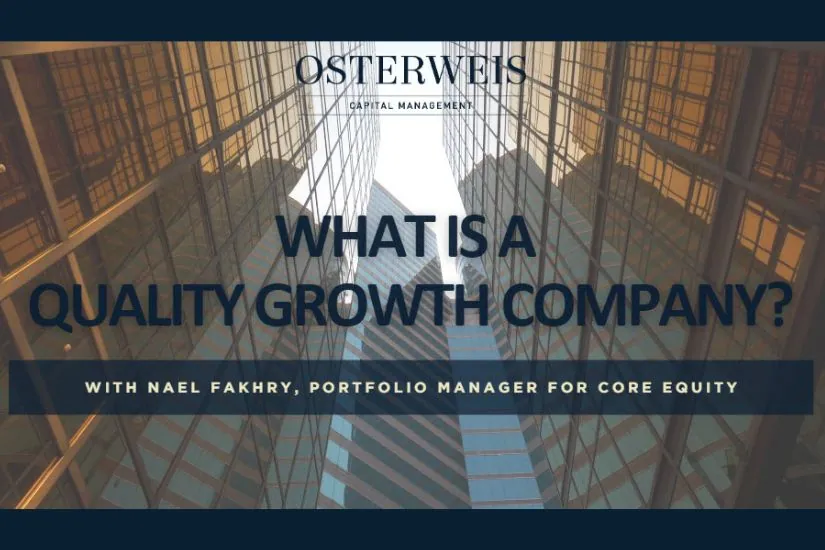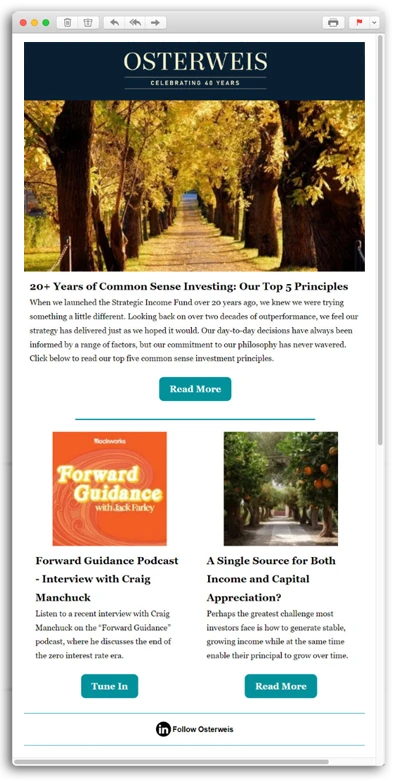Overview
Investment Objective
The Fund seeks long-term total returns and capital preservation.
Investment Strategy
- Allocate assets based on the relative investment opportunity set
- Focus on managing downside risk
- Utilize a bottom-up, fundamental investment process
- Take disciplined and repeatable approach
- Leverage experienced portfolio management team
NAV as of 12/17/25
| Price | $17.23 | Change | $-0.11 |
|---|
Fund Facts
| Ticker | OSTVX |
|---|---|
| CUSIP | 74316J771 |
| Inception Date | 8/31/2010 |
|
Net Assets (as of 11/30/25) |
$190 million |
| Number of Equity Holdings | 37 |
| Number of Fixed Income Holdings | 121 |
Fund Documents
| Document | Date |
|---|---|
| Fact Sheet | Sep 2025 |
| Summary Prospectus | Jun 2025 |
Explore our mutual fund options and start your investment journey.
Invest With UsInvestment Team
Carl Kaufman
Co-President, Co-Chief Executive Officer, Chief Investment Officer – Strategic Income & Managing Director – Fixed Income
Performance
Performance
as of 11/30/25
| Fund | 1 MO | QTD | YTD | 1 YR | 3 YR | 5 YR | 10 YR | 15 YR |
INCEP (8/31/2010) |
|---|---|---|---|---|---|---|---|---|---|
| OSTVX | 2.00% | 2.47% | 10.99% | 9.16% | 10.75% | 7.61% | 8.64% | 8.71% | 9.07% |
| 60% S&P 500 Index/40% Bloomberg U.S. Aggregate Bond Index | 0.40% | 2.06% | 13.73% | 11.36% | 14.05% | 8.98% | 9.67% | 9.76% | 10.13% |
| S&P 500 Index | 0.25% | 2.59% | 17.81% | 15.00% | 20.57% | 15.28% | 14.63% | 14.55% | 15.22% |
| Bloomberg U.S. Aggregate Bond Index | 0.62% | 1.25% | 7.46% | 5.70% | 4.56% | -0.31% | 1.99% | 2.36% | 2.31% |
Gross expense ratio as of 3/31/25: 0.91%
Performance data quoted represent past performance; past performance does not guarantee future results. The investment return and principal value of an investment will fluctuate so that an investor’s shares, when redeemed, may be worth more or less than their original cost. Current performance of the Fund may be higher or lower than the performance quoted. Performance data current to the most recent month end may be obtained by calling shareholder services toll free at (866) 236-0050.
Rates of return for periods greater than one year are annualized.
as of 9/30/25
| Fund | 1 MO | QTD | YTD | 1 YR | 3 YR | 5 YR | 10 YR | 15 YR |
INCEP (8/31/2010) |
|---|---|---|---|---|---|---|---|---|---|
| OSTVX | 1.10% | 3.43% | 8.31% | 7.73% | 12.97% | 8.81% | 8.61% | 8.76% | 9.00% |
| 60% S&P 500 Index/40% Bloomberg U.S. Aggregate Bond Index | 2.63% | 5.66% | 11.43% | 11.67% | 16.71% | 9.62% | 9.99% | 9.77% | 10.10% |
| S&P 500 Index | 3.65% | 8.12% | 14.83% | 17.60% | 24.94% | 16.47% | 15.30% | 14.64% | 15.21% |
| Bloomberg U.S. Aggregate Bond Index | 1.09% | 2.03% | 6.13% | 2.88% | 4.93% | -0.45% | 1.84% | 2.26% | 2.25% |
Gross expense ratio as of 3/31/25: 0.91%
Performance data quoted represent past performance; past performance does not guarantee future results. The investment return and principal value of an investment will fluctuate so that an investor’s shares, when redeemed, may be worth more or less than their original cost. Current performance of the Fund may be higher or lower than the performance quoted. Performance data current to the most recent month end may be obtained by calling shareholder services toll free at (866) 236-0050.
Rates of return for periods greater than one year are annualized.
Hypothetical Growth of $10,000 Since Inception to 9/30/2025
(Dividends Reinvested)
(Dividends Reinvested)
(Dividends Reinvested)
(Dividends Reinvested)
Calendar Year Performance
| Date | OSTVX | 60S&P/40Agg | S&P 500 | Agg |
|---|---|---|---|---|
| 2025 YTD (as of 9/30/25) | 8.31% | 11.43% | 14.83% | 6.13% |
| 2024 | 10.53% | 15.04% | 25.02% | 1.25% |
| 2023 | 14.76% | 17.67% | 26.29% | 5.53% |
| 2022 | -14.99% | -15.79% | -18.11% | -13.01% |
| 2021 | 17.70% | 15.86% | 28.71% | -1.54% |
| 2020 | 17.54% | 14.73% | 18.40% | 7.51% |
| 2019 | 22.23% | 22.18% | 31.49% | 8.72% |
| 2018 | -7.33% | -2.35% | -4.38% | 0.01% |
| 2017 | 12.85% | 14.21% | 21.83% | 3.54% |
| 2016 | 9.82% | 8.31% | 11.96% | 2.65% |
Portfolio Overview as of 9/30/2025
Asset Allocation % of Total Portfolio
| Category | Value | |
|---|---|---|
| Equities | 62.2% | |
| Fixed Income | 33.4% | |
| Cash & Equivalents | 4.4% |
Fixed Income Portfolio Allocation % of Fixed Income
| Category | Value | |
|---|---|---|
| High Yield+ | 82.9% | |
| Busted Convertibles | 8.8% | |
| Investment Grade | 7.0% | |
| Non-Agency MBS/CMO | 0.7% | |
| Equity Sensitive Convertibles | 0.6% |
Securities not included in the high yield category (e.g., convertible bonds, floating rate notes, preferred stocks) may also be rated below investment grade.
MBS/CMO = Mortgage Backed Securities/Collateralized Mortgage Obligations
Certain portfolio data may be available as of month-end. To make a request, please email us.
Portfolio Characteristics Fixed Income
| Characteristic | OSTVX |
|---|---|
| Weighted Average Coupon (%) | 6.39 |
| Weighted Average Effective Duration | 1.86 |
| Weighted Average Years to Maturity | 3.40 |
| Weighted Average Yield to Maturity (%) | 6.74 |
| 30 Day SEC Yield (Entire Fund)(%) | 2.02 |
| Income Distribution Yield (%) | 2.21 |
Click here for standardized fund performance.
Performance data quoted represent past performance; past performance does not guarantee future results. The investment return and principal value of an investment will fluctuate so that an investor’s shares, when redeemed, may be worth more or less than their original cost. Current performance of the Fund may be higher or lower than the performance quoted. Performance data current to the most recent month end may be obtained by calling shareholder services toll free at (866) 236-0050.
The characteristics are calculated only on the Fund’s fixed income holdings and cash. This information is believed to be reliable, but it is not guaranteed. Weighted averages are by security market value. Average yield to maturity excludes all bonds with yields at or above 50% and that are maturing within a year or have been called, all equity-sensitive convertibles whose price is at or above $135, and all bonds that are maturing within 5 calendar days. Effective Duration is from Bloomberg. Average coupon and yield to maturity are calculated gross of fees and expenses.
The income distribution yield is based on the prior 12 months’ distributions divided by the net asset value of the period end date. The distribution yield does not contain any return of capital.
Equity Sector Exposure % of Equities
| Category | Value | |
|---|---|---|
| Information Technology | 27.46% | |
| Industrials | 17.62% | |
| Financials | 13.80% | |
| Health Care | 10.19% | |
| Consumer Discretionary | 9.16% | |
| Communication Services | 7.52% | |
| Materials | 5.43% | |
| Real Estate | 5.36% | |
| Utilities | 3.46% | |
| Consumer Staples | 0.00% |
Maturity % of Fixed Income
| Category | Value | |
|---|---|---|
| <1 Year | 17.8% | |
| 1-3 Years | 21.4% | |
| 3-5 Years | 44.0% | |
| >5 Years | 16.8% |
Effective Duration % of Fixed Income
| Category | Value | |
|---|---|---|
| < 1 Year | 40.9% | |
| 1-3 Years | 30.5% | |
| 3-5 Years | 27.8% | |
| >5 Years | 0.8% |
Credit Quality Exposure % of Fixed Income
| Category | Value | |
|---|---|---|
| Government | 0.0% | |
| AAA | 0.0% | |
| AA | 0.0% | |
| A | 0.0% | |
| BBB | 7.2% | |
| BB | 34.7% | |
| B | 40.6% | |
| Below B | 2.7% | |
| Not Rated Securities | 14.9% |
Geographic Allocation % of Total Portfolio
| Category | Value | |
|---|---|---|
| United States (including cash & equivalents) | 93.9% | |
| France | 2.5% | |
| Canada | 1.9% | |
| United Kingdom | 0.8% | |
| Switzerland | 0.4% | |
| Australia | 0.3% | |
| Ireland | 0.3% |
Top 10 Equity Holdings % of Total Portfolio
| Holding | Value |
|---|---|
| Alphabet Inc-Class C | 4.7% |
| Microsoft Corp | 4.2% |
| Broadcom Inc | 3.5% |
| Amazon.com Inc | 3.4% |
| Visa Inc-Class A | 2.4% |
| Danaher Corp | 2.3% |
| AutoZone Inc | 2.3% |
| JPMorgan Chase & Co | 2.2% |
| American Water Works Co Inc | 2.2% |
| Airbus SE - Unsponsored ADR | 2.0% |
| Total | 29.2% |
Top 10 Fixed Income Holdings % of Total Portfolio
| Holding | Value |
|---|---|
| Tutor Perini Corp 144A 11.875% 4/30/29 | 0.6% |
| Varex Imaging Corp 144A 7.875% 10/15/27 | 0.6% |
| Unisys Corp 144A 10.625% 1/15/31 | 0.6% |
| Herc Holdings Inc 144A 7.000% 6/15/30 | 0.6% |
| Allegiant Travel Co 144A 7.250% 8/15/27 | 0.6% |
| Cable One Inc 0.000% 3/15/26 | 0.5% |
| JetBlue Airways Corp / JetBlue Loyalty LP 144A 9.875% 9/20/31 | 0.5% |
| Global Partners LP / GLP Finance Corp 144A 7.125% 7/1/33 | 0.5% |
| New Home Co Inc 144A 9.250% 10/1/29 | 0.4% |
| Adams Homes Inc 144A 9.250% 10/15/28 | 0.4% |
| Total | 5.3% |
Complete holdings are generally available ten business days following quarter end.
The Growth & Income Fund’s holdings and sector allocations may change at any time due to ongoing portfolio management. References to specific investments should not be construed as a recommendation to buy or sell the securities by the Fund or Osterweis Capital Management.
Fiscal Year Turnover
| Year Ended March 31 |
Turnover |
|---|---|
| 2025 | 44% |
| 2024 | 32% |
| 2023 | 33% |
| 2022 | 34% |
| 2021 | 51% |
| 2020 | 51% |
| 2019 | 47% |
| 2018 | 55% |
| 2017 | 53% |
| 2016 | 44% |
Not a full year, only covers 8/31/10-3/31/11
Fees & Distributions
Distribution Schedule
The Osterweis Growth & Income Fund distributes income four times per year (beginning September 2021) and capital gains once a year in December.
| Record Date | Ex./Pay and Reinvest Date | |
|---|---|---|
| Q1 2025 Income Distribution | 3/26/25 | 3/27/25 |
| Q2 2025 Income Distribution | 6/25/25 | 6/26/25 |
| Q3 2025 Income Distribution | 9/25/25 | 9/26/25 |
| Q4 2025 Income & Cap. Gains Distribution | 12/12/25 | 12/15/25 |
Recent Distribution History
| EX./PAY AND REINVEST DATE | ORDINARY INCOME | SHORT-TERM CAP. GAINS | LONG-TERM CAP. GAINS | TOTAL DISTRIBUTION | REINVEST NAV |
|---|---|---|---|---|---|
| 12/15/25 | $0.10195 | $0.00000 | $0.23038 | $0.33233 | 17.39 |
| 9/26/25 | $0.08948 | $0.00000 | $0.00000 | $0.08948 | 17.30 |
| 6/26/25 | $0.09621 | $0.00000 | $0.00000 | $0.09621 | 16.80 |
| 3/27/25 | $0.08916 | $0.00000 | $0.00000 | $0.08916 | 16.16 |
| 12/16/24 | $0.11043 | $0.04085 | $1.13518 | $1.28646 | 16.74 |
| 9/16/24 | $0.09151 | $0.00000 | $0.00000 | $0.09151 | 17.50 |
| 6/17/24 | $0.11305 | $0.00000 | $0.00000 | $0.11305 | 17.20 |
| 3/15/24 | $0.09660 | $0.00000 | $0.00000 | $0.09660 | 16.85 |
| 12/15/23 | $0.12157 | $0.01535 | $0.21189 | $0.34881 | 15.97 |
| 9/15/23 | $0.09839 | $0.00000 | $0.00000 | $0.09839 | 15.43 |
| 6/15/23 | $0.12351 | $0.00000 | $0.00000 | $0.12351 | 15.52 |
| 3/15/23 | $0.14809 | $0.00000 | $0.00000 | $0.14809 | 14.69 |
| 12/15/22 | $0.01567 | $0.00000 | $1.01025 | $1.02592 | 14.95 |
| 9/15/22 | $0.07777 | $0.00000 | $0.00000 | $0.07777 | 16.00 |
| 6/15/22 | $0.06720 | $0.00000 | $0.00000 | $0.06720 | 15.90 |
| 3/16/22 | $0.01430 | $0.00000 | $0.00000 | $0.01430 | 17.56 |
| 12/15/21 | $0.09006 | $0.10919 | $0.81079 | $1.01004 | 18.47 |
| 9/15/21 | $0.43780 | $0.00000 | $0.00000 | $0.43780 | 18.90 |
Insights
Literature
| Document | Date |
|---|---|
| Fact Sheet | September 2025 |
| OSTVX Shareholder Letter | October 2025 |
| Summary Prospectus | June 2025 |
| Statutory Prospectus | June 2025 |
| Document | Date |
|---|---|
| Statement of Additional Information | June 2025 |
| Annual Report | March 2025 |
| Semi-Annual Report | September 2025 |
| Proxy Voting Record (N-PX) | June 2025 |
Where applicable, charts illustrating the performance of a hypothetical $10,000 investment made at a Fund’s inception assume the reinvestment of dividends and capital gains, but do not reflect the effect of any applicable sales charge or redemption fees. Such charts do not imply any future performance. During the period noted, fee waivers or expense reimbursements were in effect for the Growth & Income Fund.
Source for any Bloomberg index is Bloomberg Index Services Limited. BLOOMBERG® is a trademark and service mark of Bloomberg Finance L.P. and its affiliates (collectively “Bloomberg”). Bloomberg owns all proprietary rights in the Bloomberg Indices. Bloomberg does not approve or endorse this material, or guarantees the accuracy or completeness of any information herein, or makes any warranty, express or implied, as to the results to be obtained therefrom and, to the maximum extent allowed by law, neither shall have any liability or responsibility for injury or damages arising in connection therewith.
The 60/40 blend is composed of 60% S&P 500 Index (S&P) and 40% Bloomberg U.S. Aggregate Bond Index (Agg) and assumes monthly rebalancing. The S&P is widely regarded as the standard for measuring large cap U.S. stock market performance. The Agg is widely regarded as a standard for measuring U.S. investment grade bond market performance. These indices do not incur expenses and are not available for investment. These indices include reinvestment of dividends and/or interest income.
Certain portfolio data may be available as of month-end. To make a request, please email us.
Past performance does not guarantee future results.
The Osterweis Funds are available by prospectus only. The Funds’ investment objectives, risks, charges, and expenses must be considered carefully before investing. The summary and statutory prospectuses contain this and other important information about the Funds. You may obtain a summary or statutory prospectus by calling toll free at (866) 236-0050, or by visiting www.osterweis.com/statpro. Please read the prospectus carefully before investing to ensure the Fund is appropriate for your goals and risk tolerance.
Mutual fund investing involves risk. Principal loss is possible.
The Osterweis Growth & Income Fund may invest in small- and mid-capitalization companies, which tend to have limited liquidity and greater price volatility than large-capitalization companies. The Fund may invest in foreign and emerging market securities, which involve greater volatility and political, economic and currency risks and differences in accounting methods. These risks may increase for emerging markets. The Fund may invest in Master Limited Partnerships, which involve risk related to energy prices, demand and changes in tax code. The Fund may invest in debt securities that are un-rated or rated below investment grade. Lower-rated securities may present an increased possibility of default, price volatility or illiquidity compared to higher-rated securities. Investments in debt securities typically decrease in value when interest rates rise. This risk is usually greater for longer-term debt securities. From time to time, the Fund may have concentrated positions in one or more sectors subjecting the Fund to sector emphasis risk. Investments in preferred securities typically have an inverse relationship with changes in the prevailing interest rate. Investments in asset-backed and mortgage-backed securities include additional risks that investors should be aware of such as credit risk, prepayment risk, possible illiquidity and default, as well as increased susceptibility to adverse economic developments.
While the fund is no-load, management fees and other expenses still apply. Please refer to the prospectus for more information.
Osterweis Capital Management is the adviser to the Osterweis Funds, which are distributed by Quasar Distributors, LLC.











